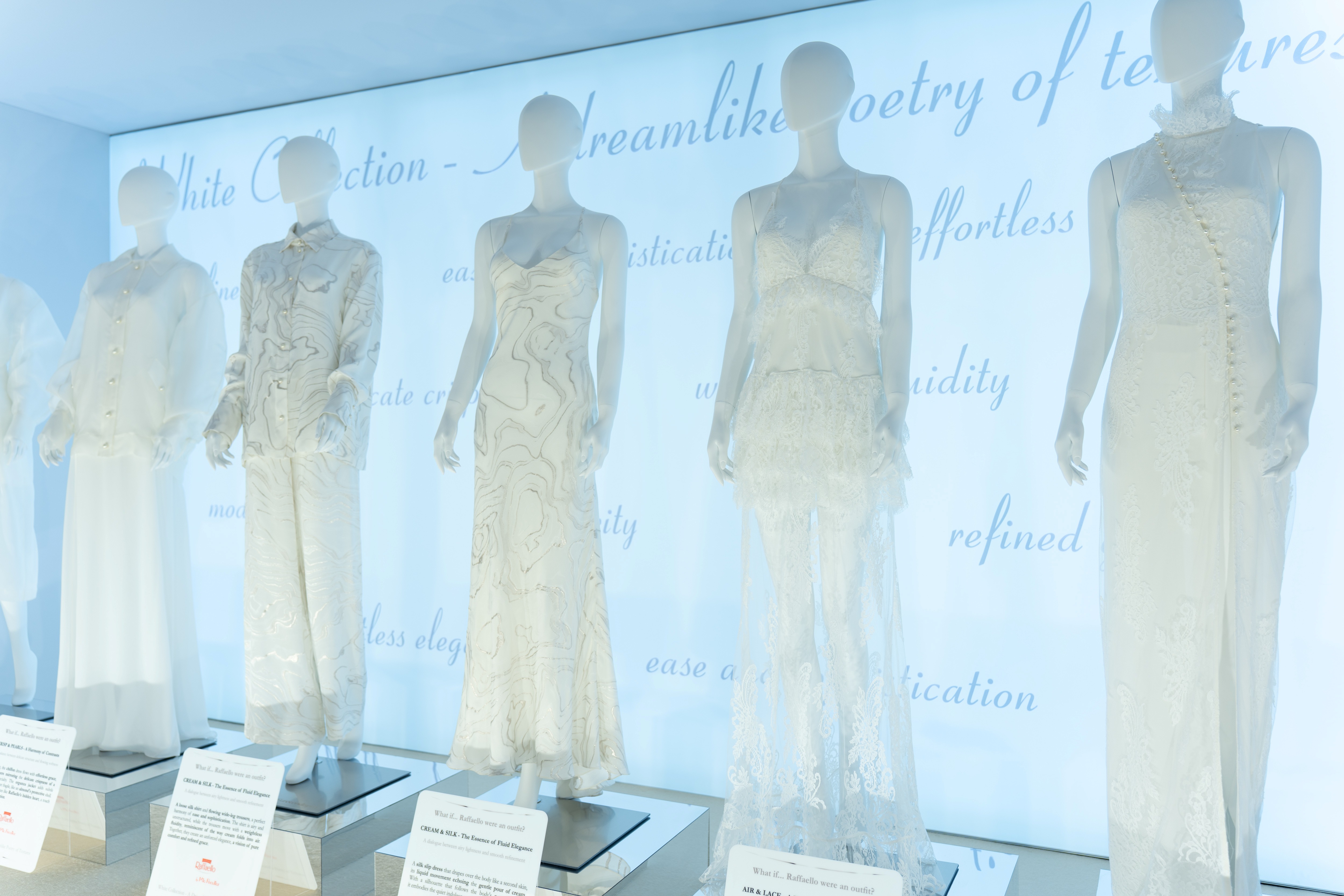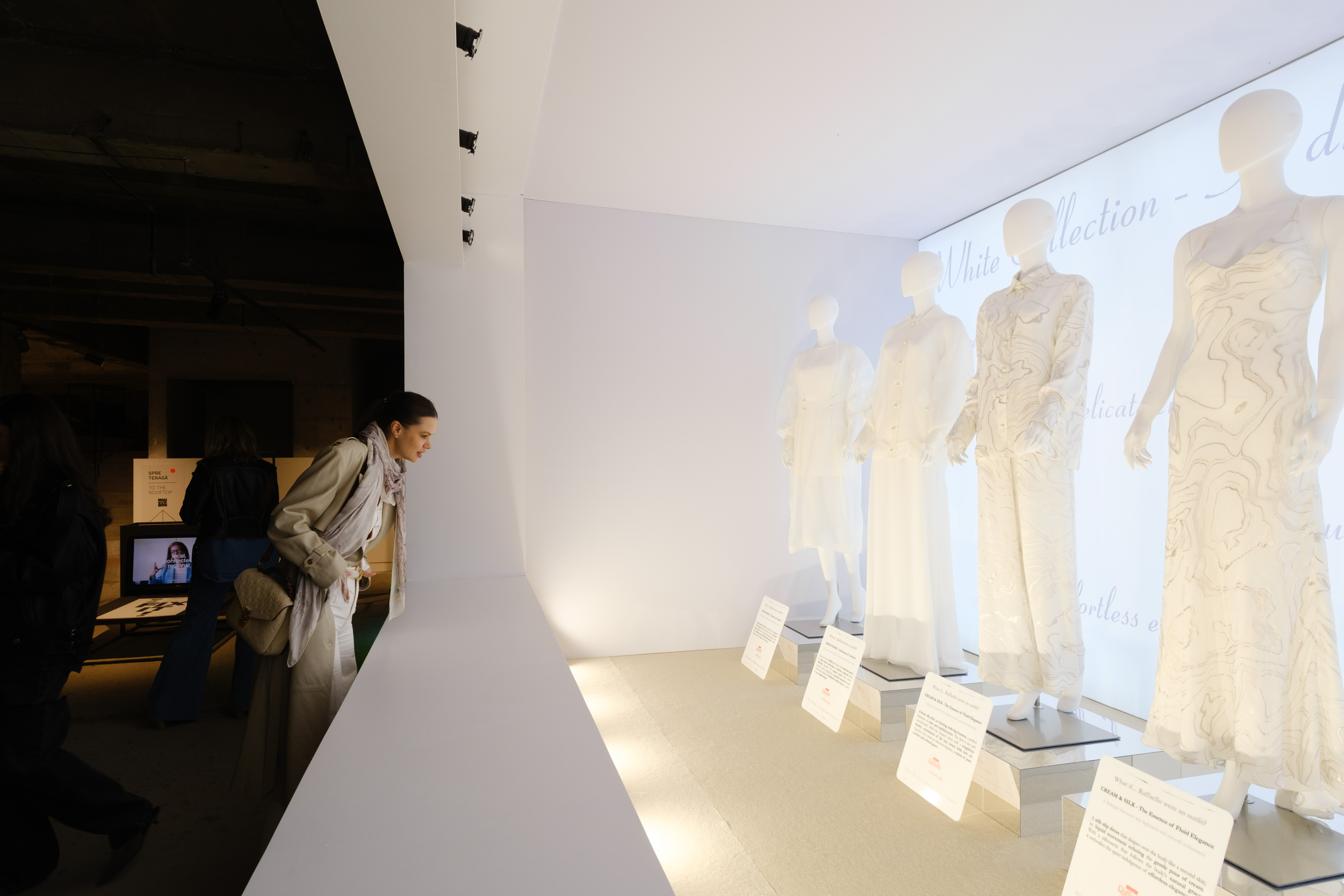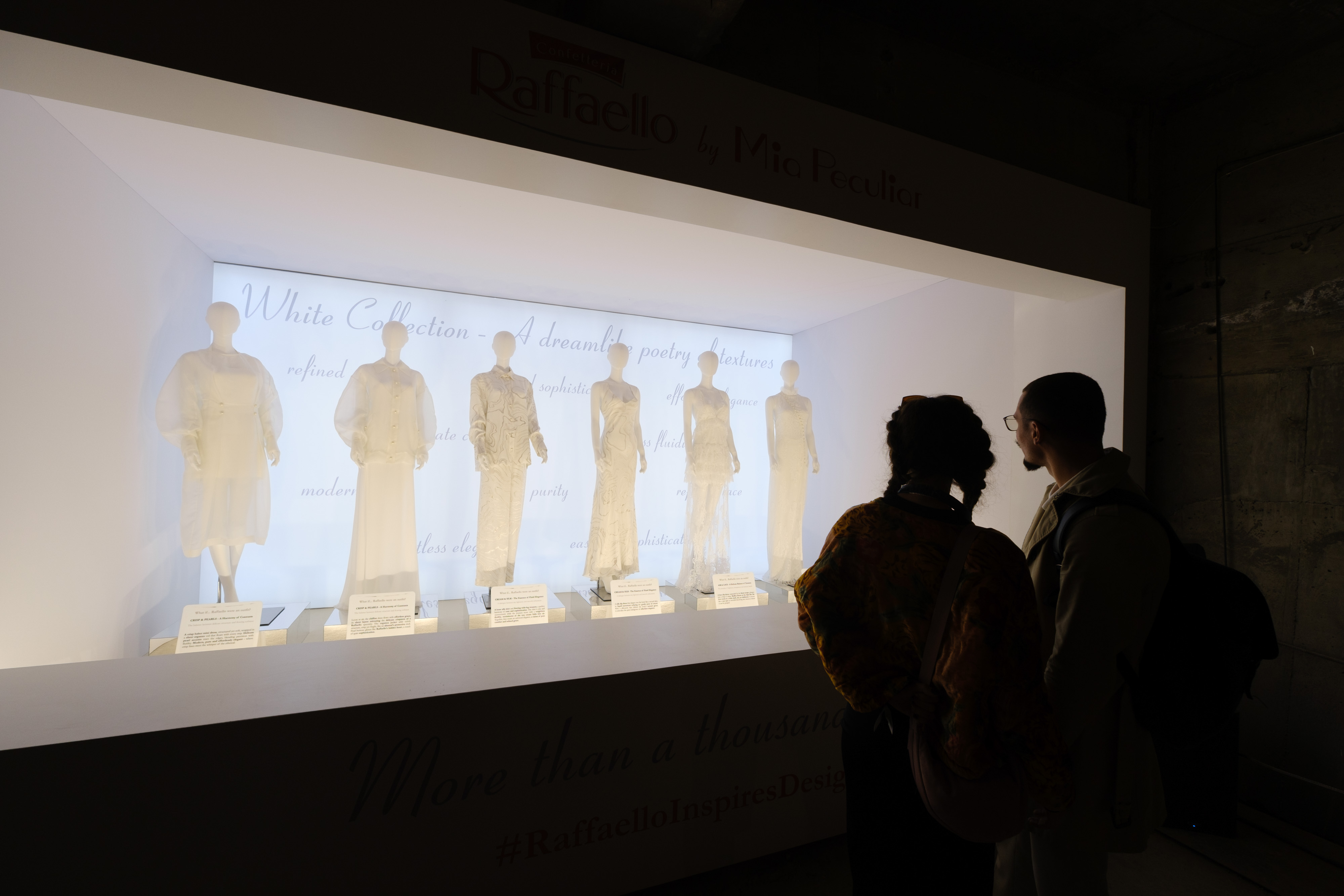After nearly a decade in Milan — where she taught pattern-making at Istituto Marangoni and collaborated with some of the industry’s most influential names — Costina Costa-Foru returns to Romania to launch Mia Peculiar, a brand that blends sensuality with structure, delicacy with strength. Positioned at the intersection of fashion and tactile poetry, the Raffaello by Mia Peculiar – White Collection explores contemporary femininity through a language of contrasts and refined materials.
The collection was showcased during Romanian Design Week 2025 in an exhibition format that highlights the dialogue between fashion and emotion. We spoke with Costina about her professional journey, how a candy can be translated into a fashion piece, and what it means to build an independent brand between Milan and Bucharest.

- The Raffaello by Mia Peculiar collection is truly unique — how did you translate the essence of a candy into a fashion collection? What inspired you most in this process?
The Raffaello by Mia Peculiar – White Collection was born from a simple question: what would a Raffaello candy look like if it were transformed into a piece of clothing? Its title, A Dreamlike Poetry of Textures, reflects this conceptual approach based on contrast — between textures, volumes, and moods. The Raffaello candy is interpreted symbolically. I worked with materials that speak to the duality of modern femininity: fragile yet powerful. Femininity is explored from multiple angles here — not idealized, but questioned and revealed through design. The collection also explores contrasts: opaque vs. transparent, rigid vs. fluid, classic vs. unexpected.
- You’ve already shown this collection at Mercedes-Benz Bucharest Fashion Week, and now at Romanian Design Week in an exhibition format. What did you hope the public would feel when experiencing these pieces?
This collaboration is not only about what fashion can do, but how it can interact with other creative industries — especially within the context of Romanian Design Week. We chose an exhibition format because we wanted the public to observe the texture, construction, and concept behind each piece. Each outfit is accompanied by a story, and this format allows viewers to interact with the garments in a more profound and immersive way.
- You've built a career in Milan and taught for nearly 10 years at Istituto Marangoni — how has this experience shaped your design style and your approach to building a collection?
My nearly 10-year experience teaching pattern-making at Istituto Marangoni had a major impact on how I approach fashion design and collection development. It helped me cultivate a balance between creativity and technical precision, a keen attention to detail and proportion, and a deep respect for execution quality. Working continuously with students and fresh ideas — as well as renowned fashion brands the institute collaborates with — kept me connected to trends and challenged me to constantly refine my vision.

- Early in your career, you received a major award from Asahi Kasei Fibers Corporation. How significant was that moment for your professional path?
The award from Asahi Kasei Fibers Corporation was definitely a defining moment, especially as it came early in my career. More than the award itself, the experience — working on a project with strict criteria, using a specialized material, and presenting in front of an international jury — helped me test and grow my skills. It gave me confidence and motivated me to keep learning and evolving professionally.
- How did Mia Peculiar come to life, and what does this brand represent to you? What kind of femininity do you aim to explore through it?
Mia Peculiar was born from a desire to create a personal fashion universe where I could explore the subtle nuances of contemporary femininity. The name itself is a metaphor — referring to "my own peculiarity" — what is uniquely mine. It’s a space of expression where the aesthetics of purity, sensuality, and fragility coexist with inner strength. Through Mia Peculiar, I aim to express a refined femininity — perhaps at times contradictory — but always authentic. A femininity that is unafraid to be delicate yet strong. For me, each collection is a dialogue between the inner world and reality, between fabric and emotion, and the brand reflects this ongoing search for balance.
- What led you to return to Romania after 10 years living and working in one of fashion’s capitals? Is this a temporary return or a long-term repositioning?
After 10 years in Milan, I felt the need for a new beginning and to reconnect with my roots. The return to Romania wasn’t necessarily planned as a temporary or permanent step, but rather as a natural phase in my personal and professional evolution. I don’t know yet if it’s a temporary or final move — I prefer to see it as a new chapter, open to whatever comes next. This is where I’ve chosen to build my brand for now, but it’s more of an open repositioning, one that leaves space for new directions and opportunities, without closing the door entirely on what I built in Italy.

- What are the biggest challenges for a Romanian designer navigating both the local and international fashion scenes?
One of the biggest challenges is finding a balance between maintaining a strong local identity and meeting the expectations of an international market. As a designer, you want to preserve your authentic voice, while also being globally relevant and competitive. There are also logistical challenges — from production to distribution — and cultural differences that can influence how your brand is perceived. But perhaps the most important challenge is not losing yourself between these two worlds and managing to turn that “dual belonging” into a creative advantage.
- The collaboration with Raffaello touches on an interesting space: how can a fashion brand intersect with a lifestyle brand to create a shared experience? How did this collaboration unfold?
The collaboration emerged from shared values found in both brands’ DNA: refinement, elegance, purity, quality, timelessness, and contemporaneity. Based on the brand guidelines and identity of Raffaello, we developed a conceptual interpretation of the candy and everything it represents, both physically and symbolically. We worked on two levels: the ideological, where we tell a story about sensations, and the physical, where we translated the layers and textures of the candy into fabrics and volumes.
- You work with sophisticated materials — lace, silk, organza, pearls. How do you choose these textures, and how do they influence the story you want to tell through your designs?
I choose these types of materials not only for their beauty and elegance, but also for the exceptional quality they bring to garment construction. I place great value not just on the materials themselves, but also on the quality of execution, because I believe that’s the only way to build something truly sustainable — both aesthetically and ethically. To me, materials are part of the story I’m telling with each collection — they add depth, texture, emotion, and most importantly, lasting impact.
- What’s next for Mia Peculiar? Do you have a new collection in the works, upcoming collaborations, or plans for international expansion?
New collections will continue to be released — one even this month — generally twice a year, with some capsule collections in between. Of course, the goal is to grow Mia Peculiar into an internationally recognized brand, which is why I’ve drawn from my background in both Italy and Romania from the very beginning. As for future collaborations, they are more than welcome — I’m always excited to share experiences with other brands, even from other fields of activity.
